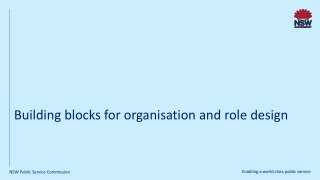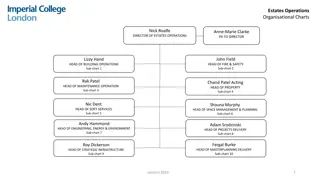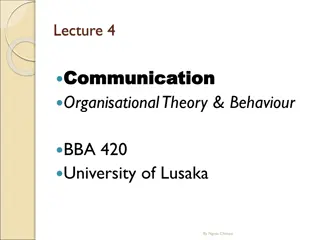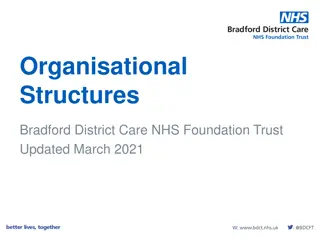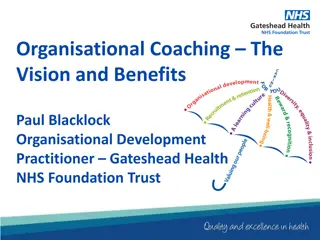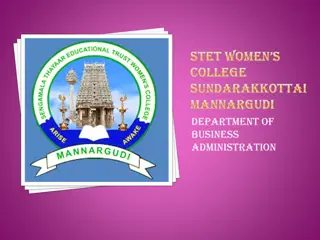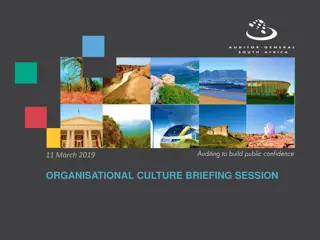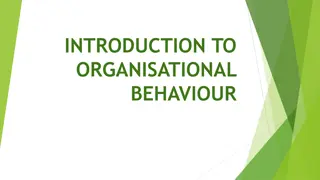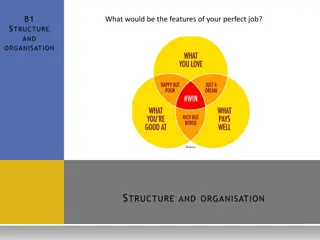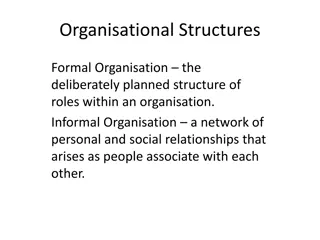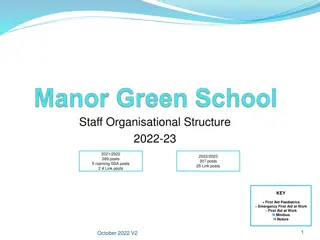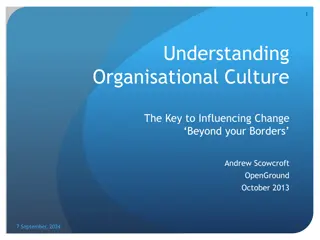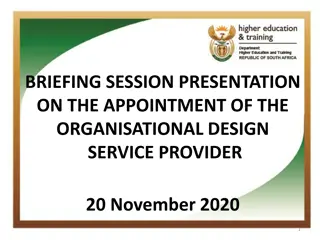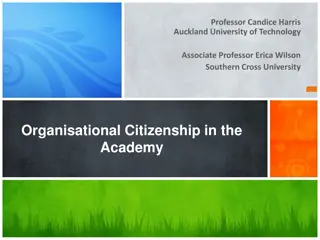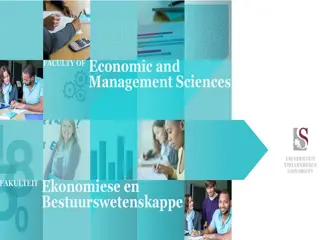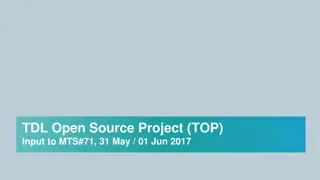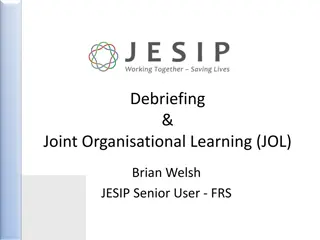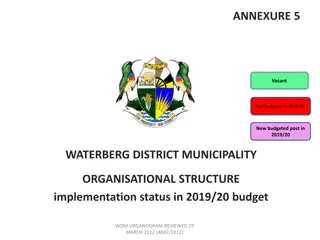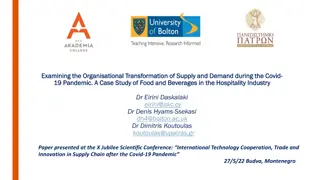Organisational Processes for Project Management
This content outlines the processes involved in project management, focusing on areas such as sponsorship, identification, competence, and delivery. It emphasizes the importance of tailoring processes to suit different contexts and the need for effective team collaboration to achieve project goals.
Download Presentation

Please find below an Image/Link to download the presentation.
The content on the website is provided AS IS for your information and personal use only. It may not be sold, licensed, or shared on other websites without obtaining consent from the author.If you encounter any issues during the download, it is possible that the publisher has removed the file from their server.
You are allowed to download the files provided on this website for personal or commercial use, subject to the condition that they are used lawfully. All files are the property of their respective owners.
The content on the website is provided AS IS for your information and personal use only. It may not be sold, licensed, or shared on other websites without obtaining consent from the author.
E N D
Presentation Transcript
Documents Resources Navigation Processes Knowledge Local
Resources Resources Resources Documents Resources Home Navigation Processes Knowledge Processes and phase gates Library Process model Navigating Praxis Navigating Praxis The pages linked from this diagram should be regarded as starting points from which organisational specific activities and practices can be developed. With the exception of sponsorship, these processes are each designed to manage a phase of the project life cycle. Tailoring Praxis Tailoring Praxis While all projects and programmes broadly follow the same life cycle, different contexts require adaptation and tailoring of the basic processes. Application Team Praxis Team Praxis Sponsorship process Sponsorship process Benefits review No No Request for authorisation Request for authorisation Yes Yes Delivery process Closure process Identification process Definition process Definition documentation Mandate Closure process Brief Identification process Definition process Delivery process Outputs Benefits realisation process Benefits realisation process Praxis Local v2.6
Resources Resources Resources Documents Resources Home Navigation Processes Knowledge Identification process Goals Application This process manages the first phase of the life cycle. Its goals are to: Competence Identification process Competence Maturity Maturity develop an outline of the project or programme and assess whether is it likely to be justifiable; Assessment Assessment Prepare brief Resources Request for authorisation determine what effort and investment is needed to define the work in detail; Resources Appoint identification team Review previous lessons Checklist Checklist Request for authorisation Mandate gain the sponsor s authorisation for the definition phase. Prepare definition plan Authorisation Overview This process will be triggered by a mandate. The first goal is addressed in the form of the brief and the second in the form of the definition plan (a form of delivery plan). At the end of the process these two documents will be presented to the sponsor with a request to authorise the definition process. Definition process Sponsorship process Definition process Sponsorship process The first activity is the appointment of an identification team. This will comprise a manager and sponsor as a minimum, plus as many specialists as are required to match the scope and complexity of the work. Key functions The identification team should identify any lessons learned that they can beneficially apply to the current project or programme. Most functions will be used at a relatively high level in order to produce the brief and definition plan. The main functions used will be: The main part of this process is then the preparation of the brief and plan for completing the definition phase. These two documents will be submitted to the sponsor who will decide whether investment in the definition phase is worthwhile. Schedule management Risk management Organisation management Stakeholder management Scope management Praxis Local v2.6
Resources Resources Resources Documents Resources Home Navigation Processes Knowledge Sponsorship process Goals Identification process Application Identification process Competence This process is designed to achieve the goals of the sponsorship function, i.e. to: provide ownership of the business case; act as champion for the objectives of the project; make go/no go decisions at relevant points in the life cycle; address matters outside the scope of the manager s authority; oversee assurance; give ad-hoc support to the management team. Competence Appoint identification team Appoint identification team Maturity Maturity Assessment Assessment Resources Resources Checklist Checklist Sponsorship process Review request for authorisation Provide management support Review Oversee assurance Confirm closure achievement of business case Overview This process comprises five independent activities. Requests for authorisation occur at the end of a phase or stage where the sponsor has to decide whether the work continues to be worthwhile. Escalation or informal request Request for authorisation Request for closure Benefits review Assurance Escalations arise when issues are outside of the manager s scope of authority and informal requests for help can arise at any time. Assurance that the work is being managed efficiently and effectively is a constant responsibility of the sponsor although the detail of conducting assurance reviews will be delegated. Key functions Sponsorship Leadership Delegation Communication Conflict management Influencing Assurance Business case management When a request for closure is submitted the sponsor must confirm that the management infrastructure may be demobilised. Where appropriate, after changes have been embedded and benefits achieved, the sponsor must oversee a review of actual benefits as compared to the agreed business case. Praxis Local v2.6
Resources Resources Resources Documents Resources Home Navigation Processes Knowledge Definition process Request for authorisation Goals Application No Closure process Closure process Request for authorisation Competence This process manages the definition phase of the project life cycle. Its goals are to: Competence Maturity Maturity develop a detailed picture of the project; Assessment Assessment Yes Definition process determine whether the work is justified; Resources Resources describe governance policies that describe how the work will be managed; Prepare governance documents Appoint definition team Checklist Authorised brief Checklist Consolidate definition documentation Delivery process gain the sponsor s authorisation for the delivery phase. Delivery process Mobilise Define scope Overview Plan delivery This process starts when the brief and definition plan produced by the identification process are approved. The first activity is to assemble the team that will complete the definition activities. This team starts by defining the scope of the work, which will inform decisions about how it should be managed, e.g. as a project or a programme; using predictive or agile approaches. Pre-authorisation work Key functions This will lead to the preparation of the governance documents and high-level delivery plans. There may also be some preparatory work that should be started early, accepting the risk that this may be wasted if the project or programme delivery is not approved. All relevant functions will be used at a high level in order to produce the definition documentation. The main functions used will be: Schedule management Risk management Organisation management Scope management Resource management Stakeholder management The consolidated definition documentation is submitted for approval to the sponsor and if authorisation is given, resources are mobilised for the first stage of delivery. Praxis Local v2.6
Resources Resources Resources Documents Resources Home Navigation Processes Knowledge Delivery process Request for authorisation Escalation Goals Application Request for authorisation Escalation Competence The goals of delivering a project are to: Competence Maturity Maturity delegate responsibility for producing deliverables; monitor the performance of the work and track against the delivery plans; take action where necessary to keep work in line with plans; escalate issues and replan if necessary; accept work as it is completed; maintain communications with all stakeholders. Exception plan Assessment Assessment Delivery process Resources Resources Checklist Checklist Corrective action Update and communicate Closure process Closure process More detail Authorisation Development process Development process Co-ordinate and monitor progress Accept completed work Overview Authorise work Boundaries process Boundaries process The delivery process is what controls the creation of the products and deliverables that collectively comprise the scope of work. Once the first stage of delivery work has been authorised, the project manager will identify the work packages to be performed. This will be delegated to the relevant teams who will report back on progress. The project manager will co- ordinate the teams and accept completed work once it has met quality control standards. As the work progresses issues may occur that cannot be easily resolved by the manager, who then escalates these to the sponsor for resolution. In some cases, an issue may require the production of an exception plan that demonstrates how an issue will be resolved and how the schedules and budgets will change. An exception plan should be submitted to the sponsor for authorisation as part of the sponsorship process. Library Shewhart cycle Shewhart cycle Key functions Assurance Communication Delegation Control Throughout the progress of the work, delivery documents will be updated, e.g. schedules, budgets, risk registers etc. Communications with stakeholders and between teams will be performed in accordance with the communications plan. Praxis Local v2.6
Resources Resources Resources Documents Resources Home Navigation Processes Knowledge Benefits realisation process Goals Application Competence Competence It is usually the case that simply producing an output does not automatically realise benefits. In most cases an output is used to change some aspect of an organisation s mode of operation or environment. The goals of this process are to: Maturity Benefits realisation process Maturity Prepare for transition Manage transition Conclude transition Final review establish the current state of what is being changed; co-ordinate the delivery of outputs with the management of change; ensure changes are permanent; establish whether benefits have been achieved. Overview Thirdly, the changes are supported longer term to ensure they become business-as-usual , i.e. they are no longer seen as new and become embedded in the culture. Benefits are usually achieved through organisational or societal change. This process address the transition from an existing state to a future state that uses outputs to deliver benefits. Finally, at a suitable point, the effect of the changes is reviewed and the resulting benefits are valued. This is compared to the original business case to provide one measure of the success of the project. The activities follow a simple and well-established model for the management of change. Firstly, the preparation work must be done to ensure that people, processes and infrastructure are in place to make use of the outputs of the delivery process. This also involves addressing any resistance to change. Secondly, the outputs are introduced, people are helped and encouraged to adopt new behaviours, attitudes and working practices. Key functions Benefits management Change management Praxis Local v2.6
Resources Resources Resources Documents Resources Home Navigation Processes Knowledge Closure process Goals Application Request for closure Request for closure Competence Competence The goals of this process are to: Maturity Maturity close a project that has delivered all its outputs; close a project that is no longer justifiable; review the management of the work and learn lessons. Assessment Assessment Checklist Checklist Closure process Prepare for closure Hand over Demobilise Overview This process is where the temporary organisation set up to execute a project or programme is closed down and the outputs of the delivery process are handed over to their long-term owners. Review Once the end is in sight, the project team will prepare for closure. This could involve notifying stakeholders, selling off assets and demobilising staff. It will also include the finalisation of any contracts let. Individual deliverables may be handed over to their owners throughout the delivery process. The final hand over confirms that the overall product is complete and the new owner takes full responsibility for its operation. Before the final demobilisation of the project or programme organisation, the sponsor is asked to confirm that this may be done. This activity should also include the closure of budgets and a final calculation of the cost of the work. The conduct of the project or programme will be reviewed and lessons recorded to be used when setting up the next project or programme. Note: this is not the same as the final review in the benefits realisation process which reviews the success of the business case. Key functions Resource management Praxis Local v2.6
Resources Resources Resources Documents Resources Home Navigation Processes Knowledge Documentation More detail Documents fall into three categories: governance, scope and delivery. Configuration management Configuration management Governance documents set out policies, standards and guidelines for the management of the work. Some of these may be specialist documents provided by the host organisation, a client or a regulatory body. Praxis only deals with the management plans that reflect how elements of P3 management will be managed. Key functions Information management Library Templates Templates Scope documents describe the objectives in terms of outputs, outcomes and benefits. Delivery documents are the largest and most diverse group. They describe what needs to be done, when it will be done and by whom. They also support the management processes and procedures. Praxis Local v2.6
Resources Resources Resources Documents Resources Home Navigation Processes Knowledge Management plans (governance) These documents set out the way a function will be managed. The two main sections cover the policy and procedure of the function with the detail being adapted to the context of the work. This is distinct from a delivery plan, which explains the detail of how a specific piece of work will be delivered. Management plans are created according to the needs of the work. If appropriate functions may be merged into one plan or a function may be sub-divided. There is a danger that the following list of management plans appears highly bureaucratic and time consuming to prepare. The principle is simply that there are many functions that need to be managed and it is important to think about how that will be done. The range and detail of management plans should be consistent with the complexity of the work. Policy includes sections on roles and responsibilities, information management, assurance, budget and interfaces to other functions. Procedure begins with defining the steps to be used in performing the function, followed by detailed recommendations on the tools and techniques to be used in each step. Links in this table are to the Praxis Framework web site, where blank and annotated templates are available. Organisation management plan Benefits management plan Stakeholder management plan Schedule management plan Control management plan Finance management plan Information management plan Risk management plan Assurance management plan Change management plan Scope management plan Resource management plan Praxis Local v2.6
Resources Resources Resources Documents Resources Home Navigation Processes Knowledge Scope documents Scope documents describe the objectives of the work. In many cases it is possible to define standard documentation that is independent of the environment, e.g. a business case or benefit profile. In others, the content is entirely dependent upon the technical nature of the work and so Praxis simply describes what is to be achieved by the document but cannot define any detail, e.g. a specification. Links in the Title column of these tables are to the Praxis Framework web site. The standard scope documents in Praxis are: Title Content Title Content Mandate The mandate is the document that triggers the start of the identification process. Benefits map A benefits map is needed where there are complex relationships between multiple outputs, benefits and the strategic objectives. Vision statement The vision statement is a means of communicating the essence of the work to stakeholders. Benefit profile A benefit profile is used to define both benefits and dis-benefits. Specification Specifications define outputs and are created by the solutions development procedure. Business case The business case is the central document to a project life cycle. It describes the expected value of benefits and confirms their desirability, achievability and viability. Product documents The extent and detail of product documentation is very dependent upon the context of the work. Praxis provides a list of fields from which suitable documents should be constructed. Brief The brief is created by the identification process and is one of the documents submitted to the sponsor to seek approval to start the definition process. Blueprint A blueprint is a form of specification. It is applicable to programmes of business change where the ultimate objective is a changed organisation and working methods. Praxis Local v2.6
Resources Resources Resources Documents Resources Home Navigation Processes Knowledge Delivery documents While the management plans set out the governance principles for how the work will be managed and the scope documentation defines what should be achieved, the delivery documents are at the heart of actually doing the work. Delivery documents are the most dynamic of the three documentation groups and should be maintained in accordance with the principles of information management and configuration management. Which delivery documents are to be used and what their format will be, is defined in the management plans. They are primarily used in the delivery, development and boundaries processes. Links in the Title column are to the Praxis Framework web site. Title Content Title Content Definition plan Alongside the brief, this is submitted to the sponsor to seek approval for the definition process. Lessons log A lesson log captures relevant previous lessons learned and records new lesson learned. Communication plan A form of delivery plan focused on communication with stakeholders. Daily log A daily log is a personal document that records informal information not stored in any of the other defined documentation. Stakeholder register The stakeholder register records information about individuals and groups who have an interest in the work being performed. Change log The change log records requests for change and their progress through the change control procedure. Risk register The risk register records information about identified risk events. Progress report Reports on progress at regular intervals. Delivery plan Delivery plans come in various shapes and sizes, e.g. a definition plan or a communication plan. It is useful for all these to follow a consistent format. Event report Reports on progress at specific events. Follow-on actions report This report lists the actions that remain outstanding when the project team is demobilised. Issue register This register records all problems that need to be escalated from one level of management to another. Praxis Local v2.6
Resources Resources Resources Documents Resources Home Navigation Processes Knowledge Knowledge Overview This section is so named because it aligns with guides that are frequently referred to as Bodies of Knowledge . The aim is to define the building blocks of the discipline of P3 management and is based on the concept of a functional analysis. The functions described in this section are split between context and management. The knowledge section integrates with all the other sections of Praxis. Each function describes the procedures, tools and techniques that can be used in management processes. In return the method section provides a structure for the use of the functions within the life cycle. Contextual functions are not directly responsible for achieving project objectives but are part of the context which supports that endeavour. Only selected topics from this section are included in Praxis Local. Management functions are the ones that are applied in the completion of projects. Benefits management Selected contextual functions Top level management functions Schedule management Life cycle Organisation management Sponsorship Financial management Stakeholder management Support Risk management Business case management Change management Planning Resource management Control Assurance Information management Interpersonal skills Scope management Praxis Local v2.6
Resources Resources Resources Documents Resources Home Navigation Processes Knowledge Life cycle Application Goals Resources Resources Output A P3 life cycle illustrates the distinct phases that take an initial idea, capture stakeholder requirements, develop a set of objectives and then deliver those objectives. Gates The goals of life cycle management are to: Benefits realisation Long term benefits Identification Definition Delivery Closure Idea identify the phases of a life cycle that match the context of the work; structure governance activities in accordance with the life cycle phases. Overview The phased structure of life cycles facilitates the creation of governance mechanisms, such as: It all starts with someone having an idea that is worth investigation. This triggers high level requirements management and assessment of the viability of the idea to create a business case. At the end of the phase there is a gate where a decision made whether or not to proceed to more detailed (and therefore costly) definition of the work. Defined processes the management of each phase can be described as a process made up of a number of relevant activities. Stages and tranches the delivery phase can be subdivided into packages of work, typically called stages in a project and tranches in a programme. Gate reviews these are conducted at the end of a phase, stage or tranche. The sponsor will consider performance to date and plans for the next phase, stage or tranche before deciding whether the business case remains viable, practical and achievable. Post-reviews learning from experience is a key factor in maturity. Post- project reviews document lessons learned for use in the future. Benefit reviews these measure the achievement of benefits against the business case. If the idea is good enough, the work will continue to a detailed definition that produces a full justification for the work. Once again this ends in a gate where a decision is made whether or not to proceed to the delivery phase. Once the output has been produced it is usually subject to an acceptance process before being formally delivered to its new owner. The life cycle comes to an end with the closure of the project. All outputs are intended to deliver benefits and this can be shown as a final phase although it will often work partly in parallel with delivery. Praxis Local v2.6
Resources Resources Resources Documents Resources Home Navigation Processes Knowledge Sponsorship Sponsorship provides ownership of, and accountability for, the business case and ensures that the work is governed effectively. While the sponsor s primary role is to ensure that the business case continues to justify the work throughout the life cycle, this would not be possible without an effective working relationship with the project manager. To the extent that, if the business case ceases to justify continuing investment, the sponsor needs to work with the manager to redefine or prematurely close the project. Application Competence Competence Maturity The goals of sponsorship are to: Maturity Assessment Assessment provide ownership of the business case; act as champion for the objectives of the project; make go/no go decisions at relevant points in the life cycle; address matters outside the scope of the manager s authority; oversee assurance; give ad-hoc support to the management team. Resources Resources Checklist Checklist The sponsor usually has responsibility to others within the host organisation or perhaps an external client. This responsibility includes ensuring that the work is being managed effectively. The sponsor does this through assurance, which is an independent review of the management of the work. Team Praxis Team Praxis There are various names given to the role that provides sponsorship, such as: executive, senior responsible owner or client. In Praxis the role is referred to as the sponsor. A sponsor must be someone who: has the credibility to provide leadership that crosses corporate and departmental boundaries; is genuinely enthusiastic about the objectives of the project; is able and willing to commit time and energy to the fulfilment of the role. A common failure in less mature organisations occurs when the role of sponsor is not taken seriously. It must be an active role fulfilled by someone who is committed to performing the activities set out in the sponsorship process. It will depend upon the context of the work whether sponsorship is provided by an individual alone or with the support of others. See also Organisation management Where a sponsor is supported by other managers they are commonly referred to as a project board. Within a board the sponsor retains ownership of, and accountability for, the business case. Business case management Praxis Local v2.6
Resources Resources Resources Documents Resources Home Navigation Processes Knowledge Support Application Support is a set of specialist and administrative services carried out on behalf of project managers. A support infrastructure can be constituted in many different ways with many different roles within the realm of P3 management. A definitive set of goals for support is impractical but they are generally drawn from the broad list shown below: A more sophisticated support function may also cover: Maturity Maturity provision of subject matter expertise to ensure that there is access to all necessary tools and techniques; training, coaching and mentoring for the project management team; maintaining the infrastructure, momentum and drive to support communities of practice; improving, embedding and measuring capabilities to achieve higher levels of maturity; owning and deploying standard tools and techniques. Assessment Assessment Resources Resources Checklist Checklist provide administrative support to P3 managers; support the governance of P3 management; provide specialist technical support; conduct assurance. Routine administration is required on all projects. On small projects this may be performed by the project manager, but on medium to large projects a manager needs support in handling day-to-day administration. The P3 support infrastructure may range from a single person to a large team containing many different roles and specialists. The overall infrastructure may be divided into multiple offices, some temporary and some permanent. For example, a support office might provide administrative support to a specific project. An administrative support function can operate at different levels depending upon how it is constituted. It may provide: administrative help in areas such as planning, risk management, etc.; the secretariat for meetings and logistical services; technical support including collecting, analysing and presenting progress information; assurance of governance structures and standard P3 management practices through audits, health checks and phase end reviews. This is then disbanded once the work is complete. In contrast, an organisation wide support office has a permanent support role independent of the creation and completion of any individual piece of work. See also Organisation management Praxis Local v2.6
Resources Resources Resources Documents Resources Home Navigation Processes Knowledge Organisation management Application Procedure Goals Competence Competence Organisation management is concerned with creating and maintaining a management structure applicable to the project and the context in which it operates. Its goals are to: Maturity Maturity Assessment Assessment Plan Initiate Maintain Close design an organisation appropriate to the scope of work to be managed; identify and appoint members of the management team; maintain and adapt the organisation throughout the life cycle. Resources Resources Checklist Checklist Generic structure Overview Planning for organisation management includes the design of an organisation structure that will match the context and scope of the work. This will include the description of policies for appointing staff and cross-reference the relevant host- organisation HR policies. External The initiate step involves making appointments and delivering any necessary training. Sponsorship The demands on the organisation structure will usually change during the course of the project life cycle. The organisation must be amended to take these changing requirements into account. Management Finally the organisation is closed down and disbanded. Assurance Support The organisational structure of individual projects will vary according to the context and specific needs of each situation. In broad terms, the organisation will always have four main levels as shown opposite. Delivery Praxis Local v2.6
Resources Resources Resources Documents Resources Home Navigation Processes Knowledge Stakeholder management Application Goals Plan Initiate Competence Competence Stakeholder management ensures that stakeholders are appropriately involved in all aspects of the project. Its goals are to: Maturity Maturity Assessment ensure that the views and attitudes of all stakeholders are understood; influence stakeholders to be supportive of the work wherever possible; maximise the impact of supportive stakeholders; minimise the impact of unsupportive stakeholders. Assessment Resources Resources Checklist Checklist Plan Team Praxis Identify Assess Engage Team Praxis communications Overview Library Stakeholder mapping Stakeholders are individuals or groups with an interest in the project because they are involved in the work or affected by the outcomes. Detailed stakeholder maps will assess each stakeholder in terms of their interest in the work and influence over the way it is performed. Stakeholder mapping Most projects will have a variety of stakeholders with different and sometimes competing interests. These individuals and groups can have significant influence over the eventual success or failure of the work. Once the stakeholders have been assessed, plans can be put in place to communicate with them with a view to influencing their interest and influence. Working with stakeholders is a vital component of many functional procedures. For example, requirements management is based on stakeholders wants and needs, and risk context (and therefore risk management) is based on understanding stakeholder appetite for, and attitude to, risk. Plans for communication with stakeholders who have high levels of interest and influence will be different from those who have low levels interest and influence. Communications planning identifies the ideal people to engage with each stakeholder. Identifying stakeholders and understanding the relationships between their different areas of interest is usually achieved through stakeholder mapping. Stakeholder management becomes more complex when stakeholders views, roles or allegiances etc. change throughout the life cycle. For that reason, the stakeholder management steps must be repeated throughout the life cycle. Praxis Local v2.6
Resources Resources Resources Documents Resources Home Navigation Processes Knowledge Business case management Application Goals Competence Competence Business case management is the function concerned with developing, communicating and maintaining the business case. Its goals are to: Maturity Maturity Unlike most other delivery functions there is no procedure to describe the development of the business case. Its development sequence is adequately covered by activities in the Praxis process model. Assessment summarise context and delivery in a single document; explain the desirability, achievability and viability of the proposed work; develop the primary document that will be used to support a go/no go decision at all gates in the life cycle; update and maintain the business case throughout the life cycle. Assessment Resources Resources Checklist Checklist Team Praxis Team Praxis More detail Overview Investment appraisal Justification comprises three tests, i.e. is the work: Investment appraisal All projects must have a business case that demonstrates the value of their objectives. Requirements management Desirable: this is determined from requirements management which demonstrates that the objectives of the work are required by the stakeholders. Requirements management In the identification process an outline business case is incorporated into the project brief that is used by senior management to assess whether to give the go- ahead for the definition process. A detailed business case is prepared during the latter process and then used to decide whether full approval for the work should be given. Solutions development Solutions development Achievable: benefits management defines achievable benefits, solutions development specifies achievable outputs and planning establishes the practicality of the work (within any time and resource constraints). Library Once approved, the business case must be kept up to date, reflecting approved changes. In this way, it can be used as the primary document at gate reviews (e.g. at the end of a tranche or stage) to determine if the work should continue. Viable: investment appraisal assesses the financial return on investment and risk management assesses the exposure to risk in performing the work. Payback method Payback method Discounted cash flow Discounted cash flow A business case typically includes three sections: The business case is owned by the sponsor, who has ultimate accountability for ensuring that the benefits are achieved. context the background of the project and why it is needed; Value management Value management delivery summary a top level view of the stakeholders, scope, schedule, finance, risk, resource and change involved; justification - an explanation of why the work should be undertaken. Praxis Local v2.6
Resources Resources Resources Documents Resources Home Navigation Processes Knowledge Planning Application Delivery plans address seven questions: Goals Competence (governance) Competence (governance) Planning occurs broadly at two levels: governance and delivery. Why? Everyone involved in, or affected by the work should understand why it is being done. The goals of management plans used in governance are to: Competence (delivery) Competence (delivery) What? The work will be described as outputs, outcomes and/or benefits in documents such as a specification, blueprint or benefit profile. describe the principles that should be used to manage the work; provide consistency with flexibility across multiple projects. Resources Resources The goals of delivery planning are to: describe the objectives of the project; define the work required to achieve the objectives and describe how it will be performed estimate the resources and finance needed to perform the work: document the plans and update them throughout the life cycle. How? The best way to deliver the objectives is embodied in many detailed delivery plans. Team Praxis Team Praxis Who? This covers the management organisation and the delivery resources as defined in organisation management and resource management respectively. Library Estimating techniques Estimating techniques When? Schedule management determines the timing of milestones, stages, tranches, work packages and individual activities. Value management Value management Overview Where? While many projects are located in one physical location, more complex projects are spread across many locations and often time zones. At the governance level a series of management plans sets out the principles of how each aspect of the work will be managed. These plans include documents such as the risk management plan, scope management plan and financial management plan. How much? Naturally, the cost of the work is an essential component of the business case. Financial management determines how much the work will cost and how it will be funded. These governance-level plans set out policies and procedures for each aspect of management. They list preferred techniques, including templates for documentation and defined responsibilities. Key processes Management plans are produced in the definition process. Delivery plans are first produced in the definition process and then maintained throughout the life cycle. These plans ensure the quality of the P3 management processes and deliverables. Therefore, developing the governance-level plans could also be termed quality planning . Praxis Local v2.6
Resources Resources Resources Documents Resources Home Navigation Processes Knowledge Control Application Goals Competence Competence If performance is outside, or predicted to be outside, the agreed tolerances, this is classed as an issue that must be escalated to the sponsor. The sponsor and manager will then agree on the appropriate corrective action. Control involves monitoring performance against approved baselines, updating delivery documents and taking corrective action as necessary. Control is required throughout the life cycle but the goals are primarily aimed at controlling the delivery process. Maturity Maturity Assessment Assessment Resources Go/no go control is used at key decision points (gates) built into the life cycle. These are typically found at the end of a phase, stage or tranche of work and involve a major review of what has been delivered. Resources Checklist Checklist The goals of control are to: Team Praxis review performance against baselines; evaluate the effect of actual performance on future plans; take action as required to achieve planning targets or agree revised targets. Team Praxis At these decision points, the sponsor considers the available information and decides whether to proceed with the remaining work. In extreme cases a project may be terminated because it is no longer justifiable. Library Post-control is entirely retrospective. It is concerned with learning from experience through, for example, post-project reviews. Cybernetic control Cybernetic control Overview Control techniques fall into one of three broad categories: cybernetic, go/no go and post. Key processes The key element of cybernetic control is feedback. A system is monitored, feedback is provided and compared to a norm. Action is taken to align the system to the norm. The delivery process is managed using cybernetic control Requests for approval in the sponsorship process are an example of go/no-go control In P3 management, the baseline plans are the norm; monitoring provides the feedback on performance and the P3 manager takes action to adhere to the baseline plans. Tolerances are acceptable deviations from the baselines. The reviews performed in the closure process are an example of post-control. Praxis Local v2.6
Resources Resources Resources Documents Resources Home Navigation Processes Knowledge Information management Application Goals Competence Competence Information management is the collection, storage, dissemination, archiving and eventual destruction of information. Its goals are to: Initiate Plan Maturity Maturity Assessment Assessment Resources capture data accurately and consistently; develop usable information from raw data; maintain information securely and accessibly during its useful life; Resources Collect data and create information Document and store information Checklist Checklist Access and disseminate Archive Destroy support effective decision making and communication. More detail Configuration management Configuration management Overview Key documents will be subject to configuration management and the information management plan will define how information is classified and stored. Storage must be designed with accessibility, security and confidentiality in mind. Large amounts of data will be collected during the course of a project. The management teams need to take the raw data and generate information through analysis and interpretation. In the early phases of the life cycle data collection will focus requirements management and solutions development. It will then move on to the creation of management and delivery plans showing how the solution will be delivered. As the work progresses, performance data will be collected to support control. The expected distribution of documents will be set out in many relevant management plans with the stakeholder management plan being of particular significance. The timing of distribution may be set out in a communications plan and the information management system must be able to support this. P3 management methods such as those described by Praxis define a suite of standard documents and many organisations develop electronic templates to ensure consistency. Most of the information on a project is transient, i.e. it is superseded with time. This does not mean it should be destroyed. Certainly for the duration of life cycle, superseded information should be archived in case it is needed in the future. This is particularly relevant in the case of contract documentation that may be called on in the event of a dispute. Praxis Local v2.6
Resources Resources Resources Documents Resources Home Navigation Processes Knowledge Scope management Goals Scope management Application Competence Competence Scope management identifies, defines and controls objectives, in the form of outputs, outcomes and benefits. Its goals are to: Develop products Maturity Maturity Solutions development Assessment Assessment identify stakeholder wants and needs; specify outputs, outcomes and benefits that meet agreed requirements; maintain scope throughout the life cycle. Resources Change control Resources Specification Checklist Work definition Requirements management Checklist Team Praxis Team Praxis Overview Benefit profiles Configuration management More detail Scope management is made up of five main areas that work in unison to identify, define and control the scope: Benefits management Requirements management Requirements management 1. Requirements management captures and analyses stakeholder views of the work s objectives. Requirements are solution-free , i.e. they describe the stakeholders wants and needs but do not determine the outputs required to meet them. Realise benefits Solutions development Solutions development Benefits management Benefits management 4. Change control is a procedure that captures and assesses potential changes to scope. It ensures that only desirable, achievable and viable changes are made. 2. Solutions development takes the requirements and investigates how they may be met while providing the best return on investment. Change control Change control Configuration management Configuration management 5. Configuration management monitors and documents the development of products. It records approved changes and archival of superseded versions. The information in a configuration management system will help the assessment change requests 3. Benefits management takes requirements that have been expressed in terms of benefits and manages them through to their eventual delivery. Benefits management is usually dependent upon change management to convert outputs into outcomes and derive benefits from outcomes. Praxis Local v2.6
Resources Resources Resources Documents Resources Home Navigation Processes Knowledge Benefits management Goals Application Competence New opportunities Competence Benefits management defines benefits, implements the necessary change and ensures the benefits are realised. Its goals are to: Maturity Maturity Baseline benefit requirements Plan Assessment Realise Quantify Value Assessment realisation define benefits and dis-benefits of the proposed work; Resources Resources Checklist Checklist establish measurement mechanisms; Team Praxis May be performed as part of scope management Team Praxis implement any change needed in order to realise benefits; measure improvement and compare to the business case. More detail Initiate Plan Investment appraisal Investment appraisal Overview Despite this benefits must be quantified wherever possible since the value of benefits is a vital input to investment appraisal in the business case. The business case is owned by the sponsor who is, therefore, ultimately accountable for the realisation of the benefits in the business case. The realisation of benefits is the driving force behind any project, programme or portfolio. The definition of a benefit is broad it is simply a positive impact of change. Since any change has the potential to have a negative impact, benefits management also covers the management of dis-benefits. These are negative effects of change that the host organisation is prepared to accept as part of the cost of achieving the positive benefits. When planning the realisation of benefits, it may be possible to identify new, previously unseen benefits. These should be added to the baseline to improve the business case. Quantifying and valuing benefits can be difficult. Some benefits are tangible and some are not. Examples of tangible benefits are reduced costs or jobs created . Intangible benefits are things like improved corporate reputation or decreased risk . The actual realisation of benefits will usually be dependent upon effective change management. Benefits management and change management are brought together in the benefits realisation process. Praxis Local v2.6
Resources Resources Resources Documents Resources Home Navigation Processes Knowledge Schedule management Goals Application Competence Competence determine timescales for the work; calculate profiles of resource demand; present schedule reports in a format suitable for different stakeholders. Time Maturity scheduling Maturity Assessment Assessment Identify work Plan Initiate Report Resources Resources Resource scheduling Checklist Checklist Overview Team Praxis Team Praxis A schedule is a timetable showing the work involved in a project. It is a dynamic document that is created and maintained throughout the life cycle. Schedules can be created for different aspects of the work and these are an important means of communication with all team members and stakeholders. More detail Time scheduling During the delivery process different scenarios might test alternative ways of creating an output or responding to a risk event occurring. Testing theoretical scenarios in this way is commonly called what-if? scheduling. Time scheduling Resource scheduling Resource scheduling To be realistic, schedules must reflect the impact of resource availability, risk and estimating accuracy on the performance of the work. The more detailed models described in time scheduling and resource scheduling can be used to test different scenarios. During the definition process these may relate to alternative solutions, with the aim of understanding the schedule consequences of achieving the objectives in different ways. The factors affecting the way in which schedules are presented typically include: the level of scheduling detail required; whether schedule information needs to be combined with resource and/or scope information; the context of the work; the audience for the information. Library Breakdown structures Breakdown structures Critical path analysis Critical path analysis Gantt charts Gantt charts Resource limited scheduling Resource limited scheduling Critical chain Critical chain Praxis Local v2.6
Resources Resources Resources Documents Resources Home Navigation Processes Knowledge Financial management Application Goals Financial management covers all aspects of obtaining, deploying and controlling financial resources. Investment appraisal Competence Competence Maturity Maturity Assessment The goals of financial management are to: estimate the cost of achieving the objectives; assess the viability of achieving the objectives; secure funds and manage their release throughout the life cycle; set up and run financial systems; monitor and control expenditure. Assessment Estimate costs Secure funding Cost control Plan Initiate Resources Resources Checklist Checklist Team Praxis Team Praxis Develop budget More detail Overview Investment appraisal Investment appraisal Funding Estimated costs will be collated onto budgets for different aspects of the work. These are combined with the delivery schedule to create cash flow information. Additional budgets may be created to deal with contingency and a reserve to be held by the sponsor. Financial management is made up of three main areas: Investment appraisal is the procedure by which the viability of the work is assessed. This is one of the primary inputs to the business case. Funding is concerned with securing the investment required to complete the work and ensuring it supports cash flow. Budgeting and cost control estimates costs, predicts cash flow and then applies controls to monitor cash flow. Funding Budgeting and cost control Budgeting and cost control The exercise of securing funds continues in parallel with these steps and with the different phases of the life cycle. For example, when a mandate triggers the identification phase of a project it should come with sufficient funding to complete the identification process. Library S-curve S-curve The estimated costs are balanced against the value of benefits (as calculated in the benefits management procedure) in an investment appraisal and documented in the business case. Work is approved if it can be shown not only that the benefits outweigh the costs but also that the organisation cannot get a better return by investing the same funds elsewhere. As the work proceeds and the amount of money involved increases, financial control systems need to be implemented that are consistent with the volume and nature of financial transactions. These systems will work in conjunction with schedule management systems to predict cash flow and then track actual expenditure against budget. Praxis Local v2.6
Resources Resources Resources Documents Resources Home Navigation Processes Knowledge Risk management Application Goals Risk management allows individual risk events and overall risk to be understood and managed proactively, optimising success by minimising threats and maximising opportunities. Its goals are to: Competence Competence Maturity Maturity Assessment Plan Initiate Assessment Resources ensure that levels of overall risk within a project, programme or portfolio are compatible with organisational objectives; Resources Checklist Checklist Team Praxis Team Praxis ensure that individual risks and responses are identified; Plan Implement responses Identify Assess minimise the impact of threats to objectives; responses More detail optimise opportunities within the scope of work Risk context Risk context Risk techniques Risk techniques Overview Risk events are viewed as being either positive or negative. A negative risk (threat) is the one most people are more familiar with. It is something that will have an adverse effect on the objectives if it occurs. A positive risk (opportunity) is something that can enhance the value of the work if it occurs. Risk is inherent in all projects, programmes and portfolios because each one is a unique combination of objectives, solutions, people and context. Each project, programme and portfolio will have an inherent level of overall risk. This overall risk has two components: risk events and uncertainty. Library Probability-impact assessment Probability-impact assessment Once risk events have been identified, they are assessed for their probability and impact. Responses will be identified and recorded in a risk register. A risk event is an identifiable event that, if it occurs, will have an impact on the objectives. The key phrase here is if it occurs . Risk management is all about dealing with things that may, or may not, happen. Risk responses Risk responses Monte Carlo analysis Monte Carlo analysis The planned responses will be implemented throughout the delivery process. Decision trees Decision trees Uncertainty relates to a form of risk that cannot be identified as a specific risk event. For example, in the use of innovative technology there may be uncertainty about performance or reliability of some components. At a more mundane level every set of plans has a degree of uncertainty because they are based on estimates of varying accuracy. The procedure keeps all risks under review and regularly repeats to identify new risk events and planned responses. Praxis Local v2.6
Resources Resources Resources Documents Resources Home Navigation Processes Knowledge Change management Application Goals The achievement of benefits in a business case often requires changes to the working practices of the host organisation. These changed practices are known as outcomes and moving from the current practice to the desired outcome is achieved through change management. Competence Competence Maturity Maturity Assessment May be combined with the corresponding steps in the benefits management procedure Assessment Resources Resources Outcomes usually include a section of the organisation adopting and utilising the outputs of one or more projects. Checklist Checklist Plan Initiate Team Praxis Team Praxis The goals of change management are to: define the organisational change required to convert outputs into benefits; Library Morgan ensure the organisation is prepared to implement change; Assess Prepare Implement Sustain Morgan Kotter Kotter implement the change and embed it into organisational practice. Carnall Carnall Lewin Lewin Overview Plans will be constantly reviewed while the change is implemented and ultimately, actions must ensured that the change is embedded and sustained so that it becomes a natural part of business-as-usual. Organisations and individuals respond to change in many different ways. Resistance to change is a natural phenomenon and managing change in a controlled manner is essential if the benefits in a business case are to be realised. There are many different change management models, such as those devised by Kotter, Carnall and Lewin. Most of these can be identified as being appropriate to one or more metaphors (as shown by Morgan). The change necessary to achieve the benefits set out in the business case will be assessed. This will often involve many different people with different perspectives and consequences. Thorough preparation is essential to minimise opposition and develop support for the change. Change management and benefits management are brought together in the benefits realisation process. Praxis Local v2.6
Resources Resources Resources Documents Resources Home Navigation Processes Knowledge Resource management Goals Application Competence Resource management covers all aspects of the deployment of resources that deliver the project, programme or portfolio. Its goals are to: Competence Maturity Maturity Plan Initiate Assessment Assessment determine the best way to resource the work; Resources Resources acquire and mobilise the necessary resources; Checklist Checklist control resources throughout the life cycle; Team Praxis Procure Mobilise Control Close Team Praxis demobilise resources at the end of the life cycle; finalise all contractual arrangements. More detail Procurement Procurement Overview Contract management Mobilisation is about getting the right resources in the right place at the right time. It also covers the reverse exercise of demobilisation when the resources are no longer required. Contract management The resources needed on a project, programme or portfolio include people, machinery, materials, technology, property and anything else required to deliver the work. Resources may be obtained internally from the host organisation or procured from external sources. Mobilisation Mobilisation Once resources have been procured and mobilised, their contribution to the creation of outputs and benefits will be monitored and co-ordinated throughout the delivery process. The three main components of resource management are: Procurement is primarily concerned with identifying and selecting external suppliers but many of the principles can be applied to securing internal suppliers. The degree of formality required will depend upon the complexity of the supply chain and associated risk. As the work comes to an end, contracts will need to be closed and resources de-mobilised. Contract management deals with the continuing relationship between the management team and suppliers. This may revolve around the terms of a legal contract, an internal service level agreement or maybe simple documented agreements for supply. Praxis Local v2.6
Resources Resources Resources Documents Resources Home Navigation Processes Knowledge Assurance Application Goals Competence Competence Assurance is the set of systematic activities intended to ensure that the objectives and management processes of a project are fit for purpose. Assurance is the responsibility of the P3 sponsor. Anyone performing assurance must be independent of the management and delivery teams, and report directly to the sponsor. Maturity Maturity Assessment Assessment The goals of assurance are to: Resources Assurance resources will often come from a dedicated support organisation or project management office (PMO). It is the sponsor s responsibility to use the results of assurance to address any issues and instil confidence in the management team. Resources review management planning; monitor effectiveness of functions and processes; give stakeholders confidence that the work is being managed effectively and efficiently. Checklist Checklist Team Praxis Team Praxis The sponsor has responsibility for not only ensuring assurance happens but also that it visibly makes a positive contribution. For example: Assurance should be risk-based. This means that it concentrates on the riskier areas of what is being assured. Overview The targets of assurance can be split into two simple categories: the objectives of the work (outputs, outcomes or benefits) and the processes (project) designed to achieve them. Assurance should assist as well as check. The assurance role should be one of assisting and advising as well as reviewing. Assurance should be seen as a sign of the organisation s commitment to develop the discipline and profession of P3 management. Objectives will usually be the subject of quality control techniques, which will be defined in the appropriate management plans. The role of assurance is to audit the management plans to ensure appropriate standards have been set and check that the results of quality control have been acted upon. Processes and procedures should also be set out in the management plans. The assurance function should check that the appropriate management plans are in place, the processes and procedures are fit for purpose and competent resources are applying them. See also Sponsorship Organisation management Praxis Local v2.6
Resources Resources Resources Documents Resources Home Navigation Processes Knowledge Interpersonal skills More detail When the complexities of human behaviour are sub-divided into distinct functions it can inevitably become somewhat artificial and theoretical. But P3 sponsors, managers and team members need to understand the mechanisms by which people relate to, and interact with, other people. Simple models such as the ones referenced in this section are a useful starting point for each individual as they build their own interpersonal skill-set. The manager must also lead the stakeholder community, who do not collectively form a team and to whom delegation is rarely appropriate. The fundamental principles of interpersonal skills do not vary across the range of projects. Leadership Leadership However, the context and organisational structures do change and this leads to different challenges and different emphases in their application. Influencing Influencing When dealing with stakeholders, influencing and negotiation are more relevant. If the stakeholders are particularly senior or vital to the achievement of objectives, the P3 manager will inevitably call upon the support of the sponsor. Delegation Delegation Communication Communication Negotiation Negotiation Teamwork Teamwork Whether delegating work to a team or influencing stakeholders, conflict will inevitably arise in some form. The manager will need to have conflict management skills no matter how well honed their other interpersonal skills may be. The wheel shows the seven interpersonal skills covered by Praxis. They can be loosely arranged into those that are primarily team oriented and those that are primarily stakeholder oriented. Conflict management Conflict management Stakeholder oriented Leadership Team oriented Professionalism Professionalism Team Praxis Team Praxis The wheel takes the P3 manager as its starting point, hence leadership appears at the top. Naturally, at the heart of all human interactions is communication. Influencing Delegation Communication A manager needs to lead and motivate their management team and delivery teams. This will be through visionary leadership (ensuring people are committed to the objectives of the work) and managerial leadership (delegating work and developing teamwork). If a manager can apply these skills with professionalism and within an ethical framework, they will engender trust and respect. Negotiation Teamwork Conflict management Praxis Local v2.6
Resources Resources Resources Documents Resources Home Navigation Processes Knowledge Navigating Praxis Local Application Clicking on the Praxis logo in the top right corner takes you to the corresponding page on the Praxis web site. Jump to the Praxis Local home page These links are to related sections of the Praxis web site that help the practical application of knowledge and processes. If you are new to a topic we always recommend you check the web page after that Praxis Local acts as a useful reminder of the key points. This page More detail Links here go to topics that are more detailed components of the current topic. Unless otherwise stated (e.g.in documents), any hyperlink within the white area of a page is internal to Praxis Local. Click here to go to the corresponding page on the Praxis web site Jump to section home pages Library Links to relevant encyclopaedia entries are selected techniques. They are not a complete list of all relevant entries in the encyclopaedia. * Links here go to library entries that are relevant* to the current topic. The Praxis Framework and Praxis Local are covered by a Creative Commons BY-SA licence. This means that you are free to distribute this information provided you acknowledge the source. Move to next or previous pages or return to the level above. Praxis Local v2.6
Resources Resources Resources Documents Resources Home Navigation Processes Knowledge Additional resources An integrated route to efficient and effective project delivery that works on personal, team and organisational levels. The full Praxis encyclopaedia of tools, techniques and models for project, programme and portfolio management. The Praxis Local home page where alternative versions and updates are posted. Encyclopaedia Encyclopaedia Local 360O assessment Articles and blogs Templates 360O Blank and annotated templates for all the main documents used in Praxis Explanations of how checklists and 360O assessments can help implement good practice and develop capability maturity. Articles and blogs arranged by author. Articles and blogs Templates assessment Information about Praxis training and certification provided by APMG International. A new and growing series of videos that will include Praxis explainers, processes and encyclopaedia topics. Glossary Certification A comparative glossary with terms from all the major guides explained and compared Certification Glossary Book Team Praxis Case studies Understand how people with different communication styles perceive functions and processes in different ways. Book Team Praxis Find out how people have used the Praxis Framework. Case studies Buy the Praxis book from The Stationery Office. Available as a printed book or pdf. Praxis Local v2.6



